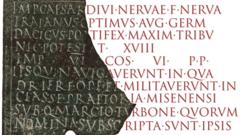Can AI Bridge the Knowledge Gaps of Ancient Rome?

A New AI Tool Revolutionizing the Study of Human History
The advent of artificial intelligence has profoundly impacted various fields, and history is no exception. A groundbreaking AI system, named Aeneas, has the potential to transform our understanding of human history, particularly with regard to ancient Roman inscriptions. Developed by a team of historians and AI specialists, Aeneas can fill in missing words from ancient texts, date inscriptions, and geographically place them with remarkable accuracy. However, the reliance on AI tools raises questions about the integrity of historical interpretation. In this article, we will explore how Aeneas works, its implications for the field of history, and the potential pitfalls of using AI in historical research.
The Role of AI in Historical Research
Artificial intelligence has made its way into numerous sectors, providing innovative solutions to complex problems. In historical research, AI can assist historians in interpreting ancient texts and inscriptions that have been difficult to read or understand. Traditionally, historians rely on their training, experience, and existing databases to make educated guesses about missing words or phrases. Aeneas aims to streamline this process, allowing researchers to access a vast database of Roman inscriptions quickly and efficiently.
With Aeneas, historians can analyze 176,000 Roman inscriptions, utilizing AI to identify relevant parallels that can support their interpretations. This automation means that historians can focus more on analysis and contextualization rather than spending countless hours piecing together fragmented texts. As historian Prof Dame Mary Beard of Cambridge University noted, the technology could open up "entirely new horizons" for the study of ancient history.
The Mechanics of Aeneas
Aeneas operates using advanced algorithms that allow it to recognize patterns and similarities in inscriptions. By comparing unknown texts with existing ones, the AI can suggest possible missing words and phrases, as well as provide historical context based on the similarities it identifies. This method is particularly beneficial for deciphering ancient inscriptions, which are often incomplete, degraded, or difficult to date accurately.
The system’s ability to analyze vast amounts of data in mere seconds sets it apart from traditional methods. Historians typically rely on their knowledge and experience to draw parallels between texts, a process that can take time and is subject to individual bias. Aeneas mitigates these issues by providing a broader scope of analysis, making it an invaluable tool for historians looking to enhance their research.
Real-World Applications: Case Studies
One of the most significant applications of Aeneas involved dating the famous Roman inscription known as the Res Gestae Divi Augusti, found at the Temple of Augustus in Ankara, Turkey. This inscription is critical for understanding Roman history, as it was composed by Augustus himself and details his accomplishments and life events. The dating of this text has been a point of contention among historians, but Aeneas managed to narrow the date range down to two viable options: between 10 and 20 CE or between 10 and 1 BCE.
The accuracy of Aeneas in this instance validates the potential of AI to assist historians in their work. In tests conducted with 23 historians, those who used Aeneas produced more accurate results than either the AI alone or the historians working independently. This finding emphasizes that Aeneas serves as a powerful assistant rather than a replacement for human expertise.
The Value of Historical Inscriptions
Inscriptions represent some of the earliest forms of writing and are invaluable to historians. They provide first-hand evidence of ancient societies, languages, and events. Yet, the challenges historians face in interpreting these texts can be immense. Many inscriptions are fragmented or have suffered degradation over time, leading to the loss of crucial information. As Dr. Thea Sommerschield noted, interpreting these inscriptions is akin to solving a gigantic jigsaw puzzle with many pieces missing.
This is where Aeneas comes into play. By filling in the gaps left by degradation and loss, the AI system allows historians to reconstruct narratives that were once thought impossible to decipher. This capability not only enhances our understanding of specific events but also contributes to a larger picture of ancient civilizations and their cultures.
Concerns and Limitations of AI in Historical Research
Despite the promising capabilities of Aeneas, there are inherent concerns regarding the use of AI in historical research. One major issue is the potential for errors in AI-generated analyses. AI systems can introduce inaccuracies, especially when interpreting complex or nuanced texts. Historians must remain vigilant and critical of the suggestions made by AI tools like Aeneas. The consensus among researchers is that AI should serve as a guiding tool rather than a definitive authority.
Dr. Yannis Assael, co-research leader and AI specialist at Google DeepMind, emphasized that historians should weigh Aeneas's predictions against their knowledge and experience. The goal is to enhance human understanding, not to replace it. Historians should approach AI-generated insights with caution, ensuring that they are grounded in rigorous scholarly methods.
The Future of AI in Historical Scholarship
As Aeneas and similar AI tools continue to evolve, the potential for transforming historical scholarship becomes increasingly apparent. The ability to analyze vast datasets rapidly will enable researchers to uncover connections and insights that may have gone unnoticed in the past. This technology opens up new avenues for interdisciplinary collaboration, as historians, linguists, and data scientists work together to push the boundaries of historical research.
Moreover, the application of AI can extend beyond Roman history. Other ancient civilizations with fragmented texts can benefit from similar methodologies, paving the way for a more comprehensive understanding of human history across different cultures and epochs. The implications of Aeneas stretch far beyond individual inscriptions; it signifies a shift in how we engage with history itself.
Ethical Considerations in AI Usage
With the integration of AI into historical research, ethical considerations also come into play. The potential for bias in AI algorithms poses significant challenges, as the datasets used to train these systems can reflect historical prejudices. It is crucial for researchers to ensure transparency in how AI tools are developed and to remain aware of the limitations and biases inherent in the data.
Furthermore, historians must maintain their integrity by critically assessing AI-generated insights. The responsibility lies with researchers to ensure that they apply ethical considerations in their methodologies, ultimately preserving the authenticity of historical interpretation.
Conclusion: Embracing the Future
The introduction of AI tools like Aeneas marks a pivotal moment in historical research, offering unprecedented opportunities to enhance our understanding of the past. By automating the process of contextualizing inscriptions and drawing parallels, Aeneas can significantly accelerate the work of historians. However, the reliance on AI must be balanced with a commitment to rigorous scholarship and ethical considerations.
As we embrace the future of historical research, the collaboration between human expertise and AI technology holds the promise of unveiling new insights into our collective past. The journey of discovery continues, and as we uncover the mysteries of ancient inscriptions, we must remain vigilant stewards of history, ensuring our interpretations are accurate and meaningful.
Frequently Asked Questions
How does Aeneas work in historical research?
Aeneas analyzes a vast database of Roman inscriptions, using AI algorithms to identify patterns and suggest missing words or phrases, thereby assisting historians in interpreting ancient texts more efficiently.
What are the main benefits of using AI in historical scholarship?
The primary benefits include increased efficiency in analyzing data, the ability to uncover connections that may have gone unnoticed, and enhanced accuracy in dating and contextualizing historical texts.
Are there risks associated with relying on AI for historical interpretation?
Yes, there are risks, including the potential for errors in AI-generated analyses and the introduction of bias. Historians must critically evaluate AI insights and ensure they apply rigorous scholarly methods.
As we venture into this new era of historical research, how do you envision AI transforming our understanding of the past? #AIinHistory #Aeneas #HistoricalResearch
Published: 2025-07-23 15:07:05 | Category: technology



